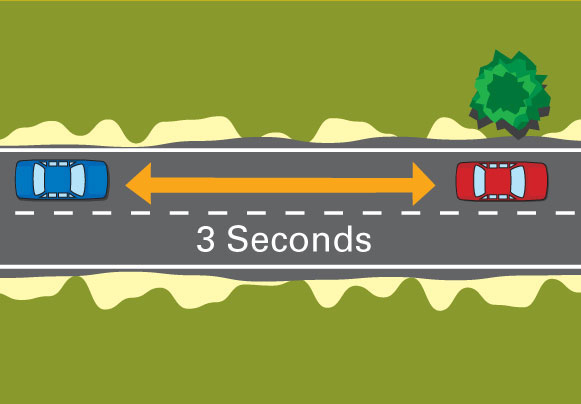The standard Safe Practices for Motor Vehicle Operations, ANSI/ASSE Z15.1, defines defensive driving skills as "driving to save lives, time, and money, in spite of the conditions around you and the actions of others.
A simpler definition is for a defensive driver - a driver who will do everything possible to avoid a collision.
Learning to drive isn't only about learning how to handle a vehicle and obeying road rules. Defensive driving is an essential skill for young drivers to learn if they want to minimise the chance of collisions which result in injury, loss of life or damage to property. One of the key principles of defensive driving is taking a mindset that other road users and pedestrians may not always follow the rules of the road. This requires expecting the unexpected and having a plan to react safely should such events occur.
We believe a safe driving school is also a defensive driving school. The following techniques will help get you thinking about these skills as your abilities will be judged during your practical driving test.
Defensive Driving Techniques
1. General principles
1.1 Controlling your speed
Speed limits apply only to ideal conditions. It is the responsibility of a safe driver to ensure that your speed matches the current conditions. Higher speeds give you less time to react and less control over your vehicle should things go wrong. You must control your speed to maintain control of your vehicle.
1.2 Look ahead and expect the unexpected
Many inexperienced or young drivers get into a habit of not looking further ahead of the vehicle in front of them. You should look as far down the road as you can. This well help you anticipate and plan ahead for situations that could potentially cause an accident.
1.3 Be alert and distraction free
A distraction is any activity that diverts your attention from the task of driving. Safe driving requires your full attention. Modern technology such as mobile phones, on-board computers, televisions, GPS navigation systems and even radios can distract from the task at hand. Whilst interacting with any of these should be avoided at all times by the driver whilst driving, it is especially important in areas where there are more prevalent hazards such as road traffic and pedestrians where literally anything can happen.
The four main types of driver distraction:
- Visual: the things you see
- Auditory: the things you hear
- Physical: the things you do with your hands
- Cognitive: the things you think about
2. Regarding other participants in traffic
2.1 Preparedness for all sorts of actions and reactions of other drivers, pedestrians and cyclists
- Avoid aggressive drivers:
- Resist getting involved in road rage incidents. Take a passive approach. Confrontation can be dangerous as you don't know what medical or mental condition another driver may have.
- Tailgaters: If a driver behind you is tailgating, let them know they're not maintaining a safe distance by tapping your breaks two or three times. If they don't back off then gradually slow down and allow the driver to overtake. Avoid making any gestures to avoid a road rage incident.
- Speeding Drivers: If a car is speeding or changing lanes behind you in an aggressive manner, maintain your speed whilst remaining in your lane. When safely possible, move to the left lane and fall back to allow more space behind the driver ahead so that the speeding driver can safely overtake you without needing to overtake several vehicles at once.
- Evasive measures: If you see someone driving aggressively then avoid them by either slowing down or pulling over.
- Be aware of all pedestrians on the side of the road. Children, the elderly, intoxicated or distracted people may behave in a manner which disregards road safety. Some may not make the decisions you expect so ensure you slow down when passing a group of pedestrians. Be aware of pedestrian blind spots such as parked vehicles and road furniture.
- Be aware of cyclists in your vicinity. Remember they have no protection from collision so afford them at least the same consideration you would a pedestrian. Give them plenty of space in case they fall as this can happen any time.
2.2 Don't assume other drivers or cyclists to do what you would do
- Don't assume another driver will move out of the way or give way for you to merge. Assume other drivers may run red lights or disregard stop signs and be prepared to react. Cover your brakes, slow down and wait to see what drivers in your path or potentially in your path may do. Anticipate the worst-case scenario and plan your actions accordingly.
- Watch and respect other drivers.
3. Regarding your own vehicle
- Maintaining a safe following distance is one of the most important defensive driving techniques. The greatest chance of a collision is in front of your vehicle. The 3 second rule will help ensure a safe following distance. This will provide adequate time to brake and stop your vehicle if necessary. In wet weather, fog, night-time or when following large vehicles or motorcycles, you should increase your following distance by one second (to 4 seconds).

- Driving safe adjusting for weather and road conditions. Slow down on wet roads. You cannot rely on your tyres to grip when you apply emergency braking. Leave more space in front of your vehicle than you would in dry conditions. Whenever you see road works or unfamiliar conditions, slow down to give you more time to make a safe decision.
- Adjust your speed before entering a bend. Lowering speed or applying your brakes when already on a bend may cause your car to skid.
See our post for common fail items to for more info about how your defensive driving skills will be observed during your VORT test.
I can help you pass your VORT!